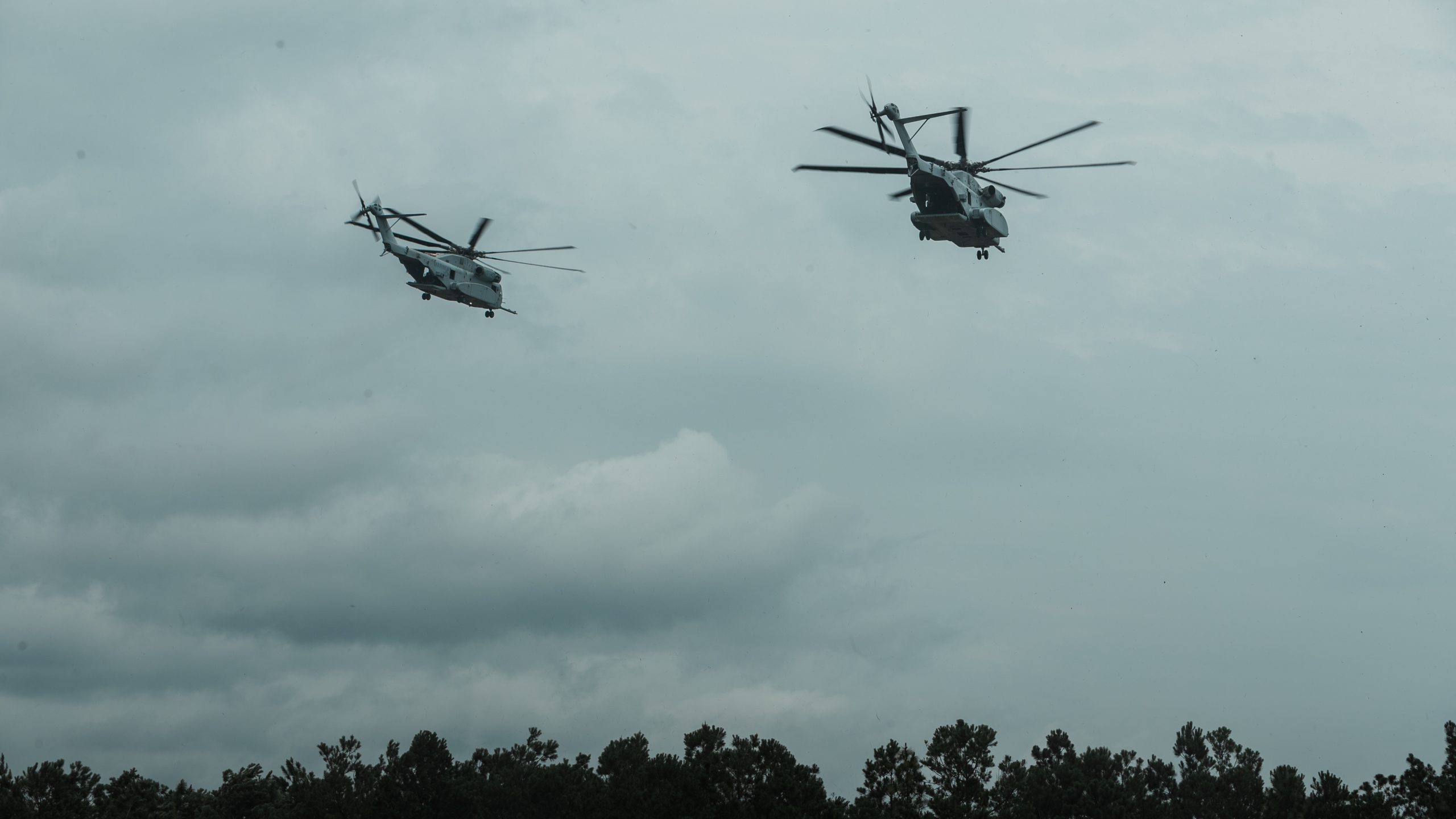As the Marines rework how they are going to shape their way ahead with regard to the joint force and full spectrum crisis management, their ability to operate from seabasses to expeditionary bases to the wider littoral operations is a crucial contribution.
With their Osprey and F-35B capabilities already providing for significant ability to move Marines across the areas of interest from HA/DR to combat operations, the coming of the CH-53K adds significant capability of logistical support to combat Marines.
Recently, NAVAIR released a video showing the progress in the new aircraft operating at night in terms of extending its range via tanking operations.
I had a chance recently to discuss this development with Colonel Jack Perrin, Program Manager, PMA-261, H-53 Heavy Lift Helicopters, Naval Air Systems Command at Patuxent River, Maryland.
In that video, seen below, which was released on July 16, 2021, the CH-53K King Stallion is seen executing night vision goggle helicopter aerial refueling.
And NAVAIR added in its note accompanying the video: “It is the Expeditionary Advanced Base Operations vertical, long-range, heavy-lift, logistic backbone of the Marine Corps, today and for the next fight. Day. Night. All weather.”
When I discussed the progress indicated in the video with Col. Perrin this is what he underscored: “We’ve now gone through and have validated the CH-53K’s performance in helicopter aerial refueling, both day, night, both with and without the external loads. This is extremely significant because now we move a heavy external load and extend our range so that we can really get anywhere that the Marines are going to need heavy lift logistics support within the world.
“I can imagine us taking off from the shipboard environment with a heavy 27,000 pound or more external load and extending our reach because we’re able to aerial refuel along the way, day or night, and deliver those logistics support wherever they need that. For example, we will be able in the PACOM region to reach the outer island chain and operate up and down the chain or the other supporting areas where the U.S. Navy might be operating.”
In my discussions in July 2021 with Lt. Col. Lukas Frank, the head of the VMX-1 CH-53K detachment, he noted that the extended reach of the CH-53K was also facilitated with the automation in the aircraft which makes longer range operations more effective as well.
As Frank put it in that interview: “You have an aircraft that can carry significant supplies or Marines inside and can carry 36,000 pounds externally. They can carry a lot of stuff. It has automated flight control systems that allows you to land in the degraded visual environments that you would not dare land an ECHO or a DELTA in. It can fly long distance without the air crew being fatigued. If you’re aerial refueling and flying 1,000 miles in the E, the air crew would be wet noodles getting out after the flight. In the K you can relax a little, take a breath, allow the aircraft to help you fly and thus reduce aircrew fatigue significantly.
“I think when the necessity for conflict rears its head the K will be able to respond, and using human ingenuity, the operators will be able to find a way to support any mission that the Marine Corps needs it to do. The K is so versatile that I don’t see people being pigeonholed into not being able to do something with a K. I think they’ll be able to answer the call 99.9% of the time.”
In other words, the automation of the aircraft which allows for ease of flight coupled with day-night air refueling capabilities makes longer range for heavy lift possible for Marines.
And these Marines are drawing upon their legacy as the joint forces most mobile and expeditionary force to enhance the ability of the joint force to operate across a combat chessboard.
As Col. Perrin noted: “Not only are flight operations more manageable for the flight crew but we are now safer because of the stability of the aircraft and the fly-by-wire system. One of the notes that we have from the development testing for the night refueling is that it was actually an ITT event, by which we mean that it is both a developmental test pilot and an operational test pilot conducting the test together.
“We have an increased safety margin associated with the 53K in executing its missions. And we can do so with heavier loads and get more performance from leveraging the digital backbone and its ability to work the networks when it’s operating. You’re also reducing the pilot workload and enhancing the safety when you’re flying behind the tanker. Going over long distances, the air crew is not flying their aircraft on altitude and airspeed. The aircraft’s flying itself.”
We then discussed the coming of the CH-53K to the North Carolina-based Marines.
From April through July, I have had the opportunity to spend time with II MEF and 2nd MAW, who are working the challenging transition from the Middle East land wars to European defense. And they are doing so without the benefit have having F-35s in their operating force. Both the II MEF and 2nd MAW commanders explicitly noted how important they saw the CH-53K for them in working that transition as they begin to operate the aircraft in their operating force.
And they are looking to leverage the new aircraft as they evolve their concepts of operations. Interestingly, 2nd MAW will be transitioning to the F-35B in the same time frame as the coming of the CH-53K which will provide an opportunity to think through how the two aircraft can interact in shaping the wing’s concepts of operations.
In discussing this development with Col. Perrin, he underscored the significant interaction which the CH-53K can have with the expeditionary basing capabilities inherent in the F-35B as a S/TOVAL aircraft. He underscored that “we can bring three 800-gallon fuel tanks with us. That’s 2,400 gallons of fuel. This means we can support multiple aircraft with all that fuel.
“That also means that the aircraft can land and get re-armed and receive fuel in a single landing operation at an expeditionary base rather than having to land to get re-armed and do an air-refueling to get fuel.”
During a recent exercise involving 2nd MAW Marines, they worked in Finland and learned how the Finns operated from roads to work in high threat environments. They also worked with the Finns in shaping the Marines own capability to do so. With CH-53K support, such coalition operations could support Marine F-35Bs or coalition aircraft whether it be the Swedish Gripens or the Finn’s F-18s.
And when thinking of expeditionary basing and support, there is another way to look at how to use that other F-35 flown by Marines, namely the F-35C.
That kind of flexibility is crucial as the U.S and its allies work the flexibility and ability necessary to operate across the combat chessboard against peer or near-peer competitors.
During a visit to MAWTS-1 last year, an F-35 pilot, Major Shockley, highlighted the impact of F35-B thinking on base mobility. In my book Training for the High-End Fight, I discussed with him how this thinking might apply to the entire F-35 force and to take advantage of the kind of expeditionary fuel support which the CH-53K could provide.
The F-35As and F-35Cs have some advantages in terms of fuel, and then range and loitering time with regard to the B, notably with regard to the C. Because the force is so inherently integratable, how best to work the chessboard of conflict with regard to where the various F-35 pieces move on the chessboard. From this standpoint, he argued for the importance of shaping a “rolodex of basing locations” where F-35s could land and operate in a crisis.
He had in mind, not only what the very basing flexible B could provide but thinking through deployment of “expeditionary landing gear” to allow the A’s and C’s to operate over a wider range of temporary air bases as well.
Here, he was referring to preparing locations with the gear to enable landing on shorter run “airfields” as well as the kind of modifications the Norwegians have done with their F-35s enabling them to land in winter conditions in the High North as well.
With the F-35B as well, a much wider range of afloat assets are being used to enable the F-35 as a “flying combat system” to operate and enable ISR, C2, and strike capabilities for the joint and coalition force. This is being demonstrated throughout the amphibious fleet, a fleet which can be refocused on sea control and sea denial rather than simply transporting force to the littorals.
A key consideration when highlighting what the F-35 as a wolfpack can bring to the force is deploying in the force multiples that make sense for the force. This rests upon how the combat systems are configured on that force. In simple terms, the integrated CNI systems operate through a multiple layer security system, allowing a four ship F-35 force to operate as one.
With the Block IV software coming into the fleet, now an eight ship F-35 force can operate similarly. This allows for wolfpack operations and with the ability of the reach of the F-35 into other joint or coalition F-35 force packages the data flowing into the F-35 and the C2 going out has a very significant reach and combat impact.
This is not widely known or understood but provides a significant driver of change to being able to operate and prevail in denied combat environments.
Leveraging this capability is critical for combat success for the U.S. and allied forces in the Pacific.
And my visits to NAWDC and MAWTs-1 certainly underscored that these warfighters get that.
CH-53KTM and King StallionTM are trademarks of the Department of the Navy
Featured Photo: U.S. Marines with Marine Operational Test and Evaluation Squadron 1 (VMX-1) extract Marines with Alpha Company, 1st Battalion, 2d Marine Regiment (1/2), 2d Marine Division (MARDIV), from a landing zone in Camp Lejeune, N.C., June 10, 2021. Marines with 1/2 executed an air assault operation in support of VMX-1 to test the capabilities of the CH-53K King Stallion, the U.S. Marine Corps’ newest heavylift helicopter. (U.S. Marine Corps photo by Cpl. Patrick King)












